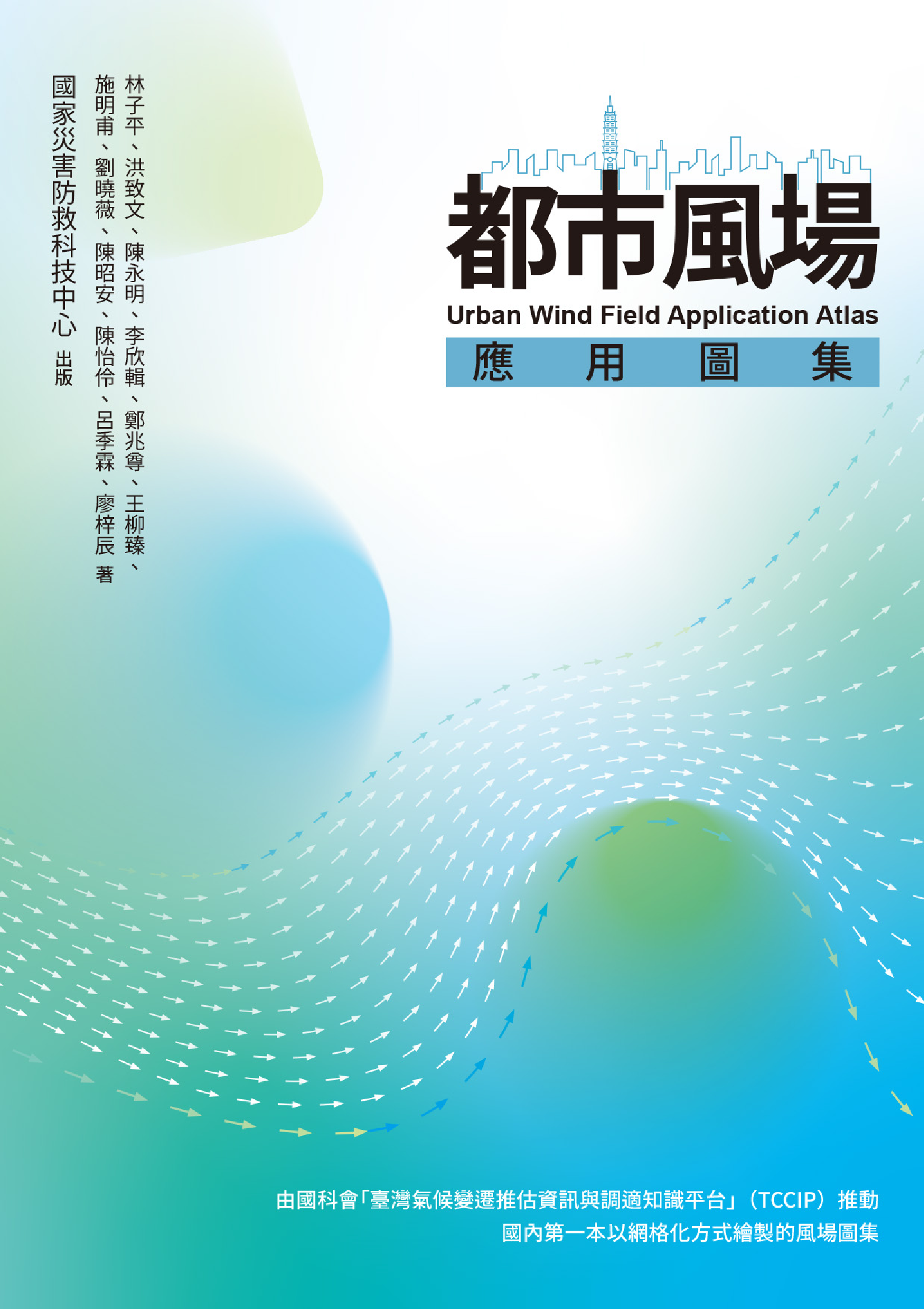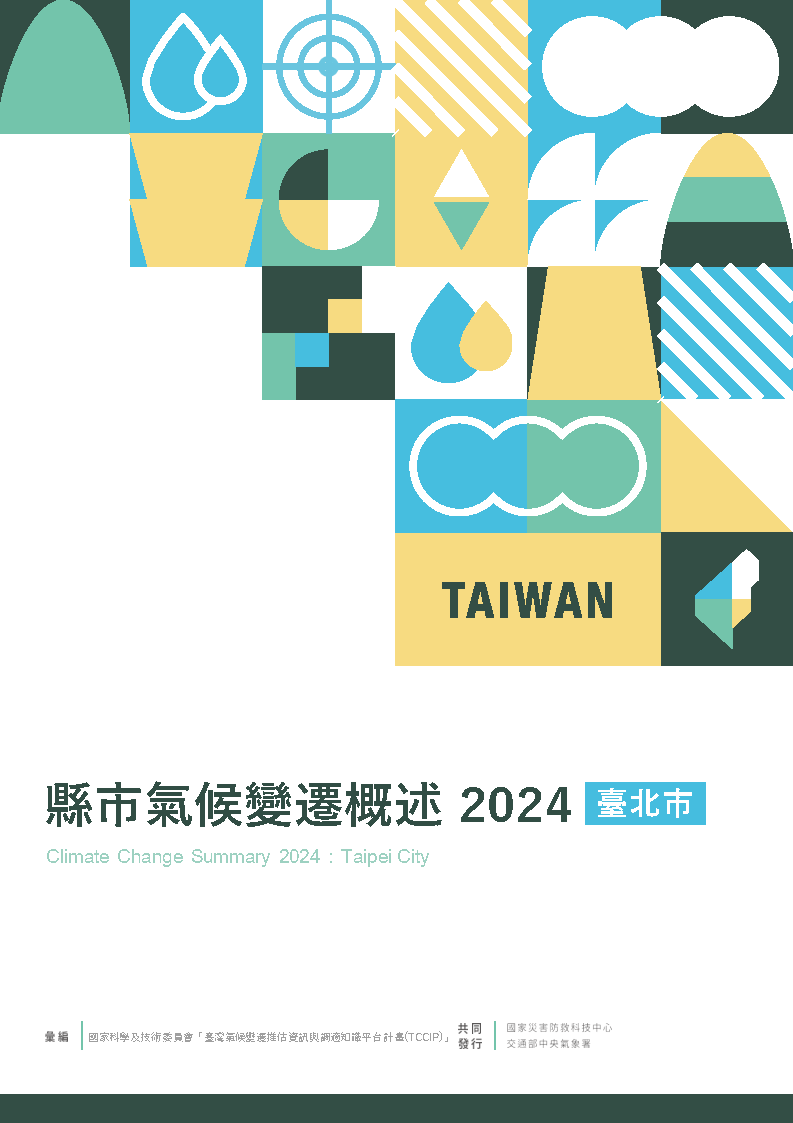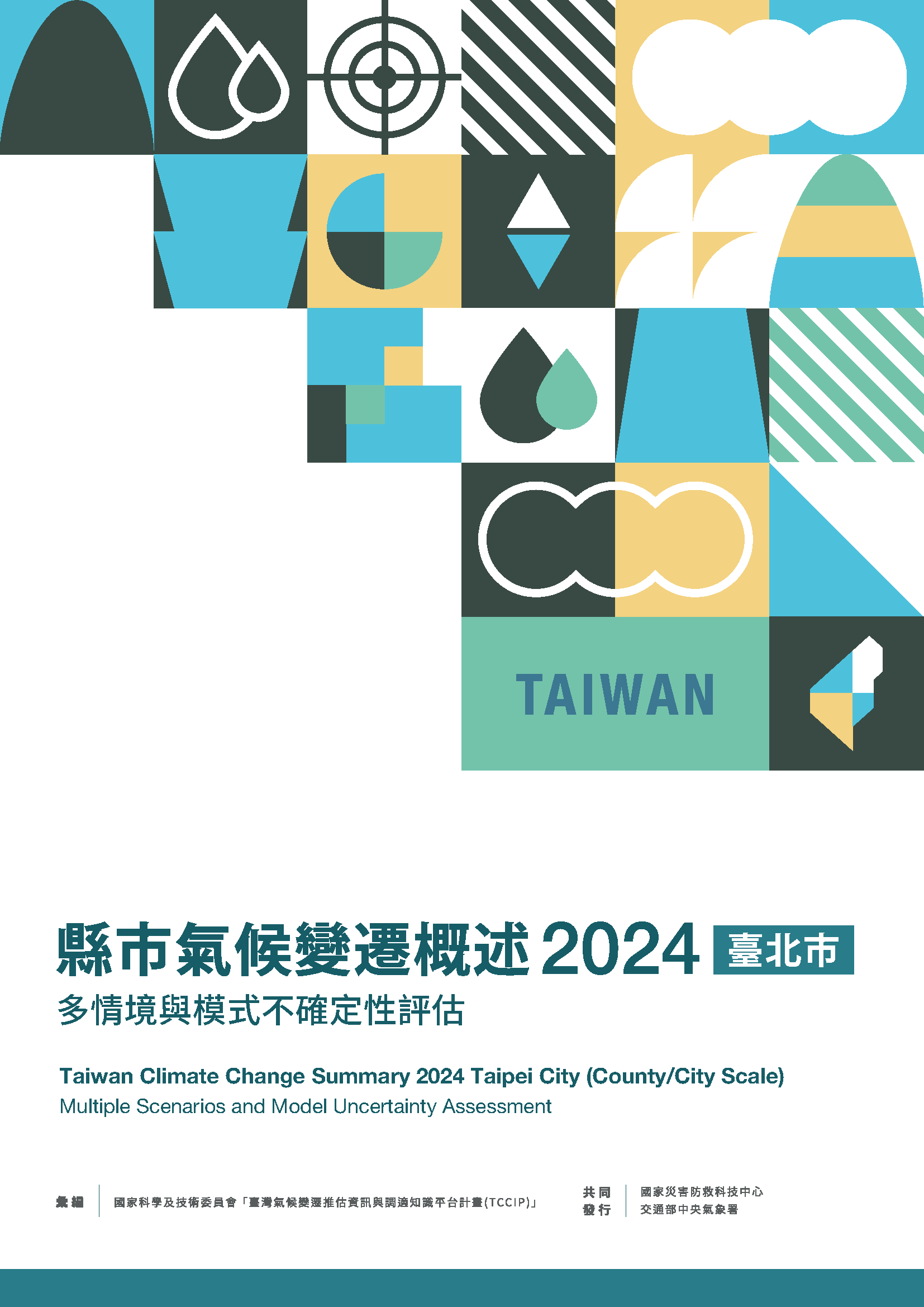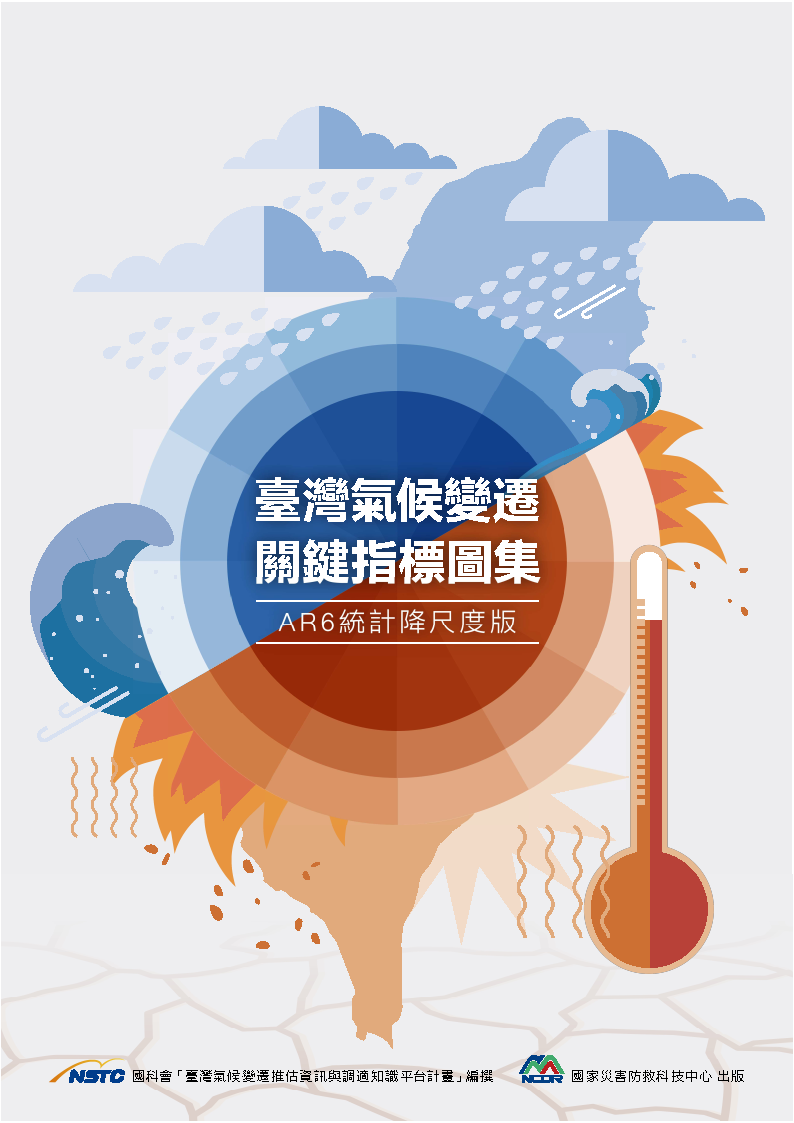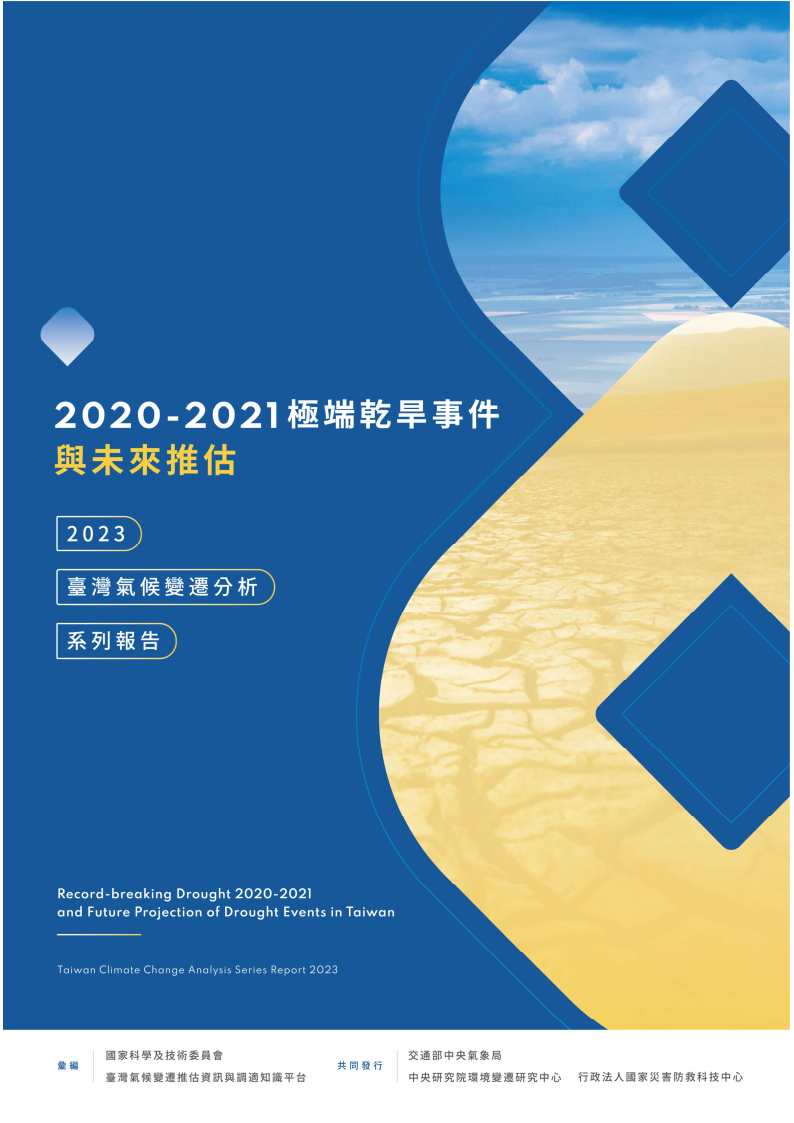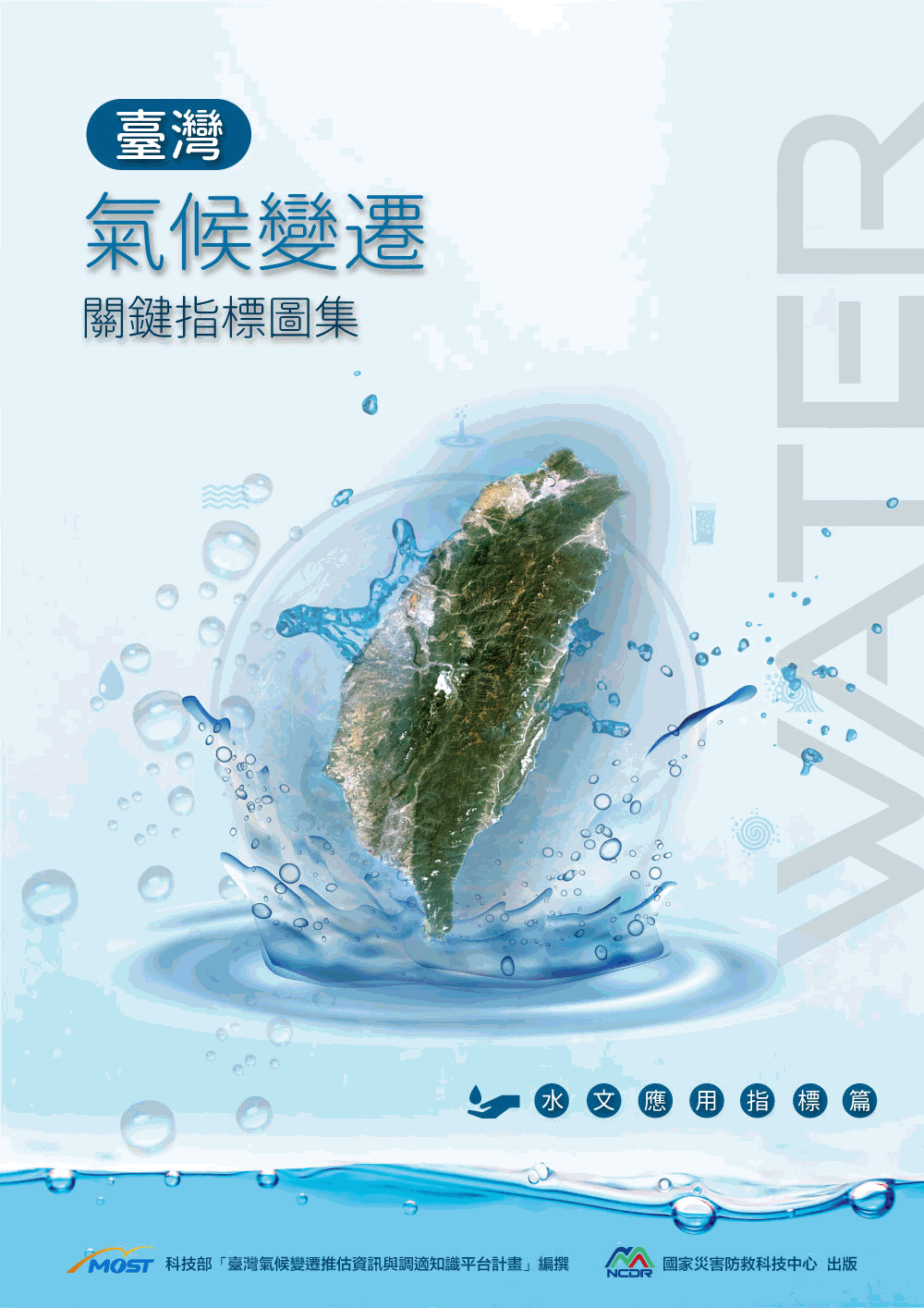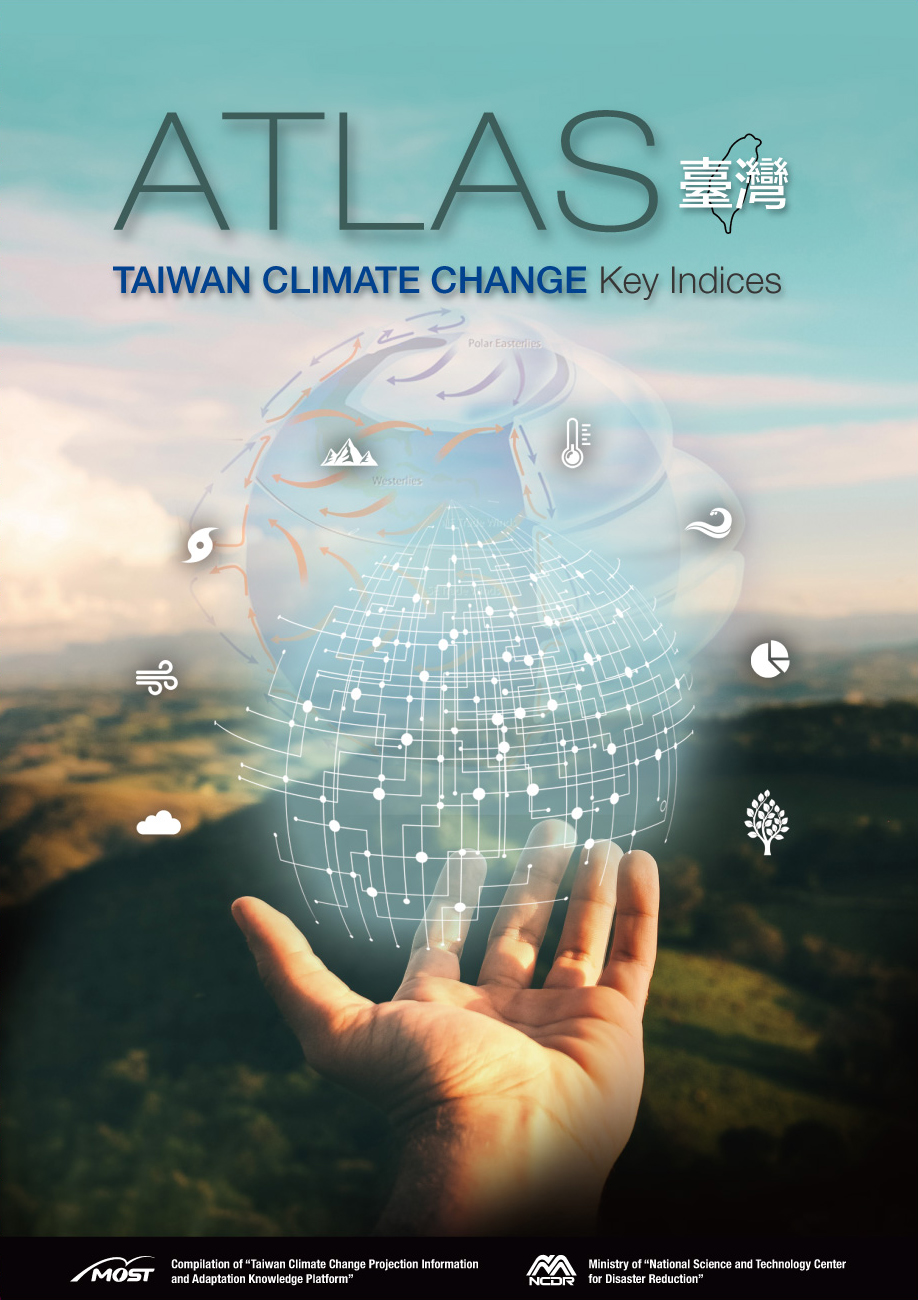Publishes
Urban Wind Field Application Atlas
Author : Tzu-Ping Lin, Chih-Wen Hung, Yung-Ming Chen, Hsin-Chi Lee, Chao-Tsun Cheng, Liu-Chen Wang, Ming-Fu Shih, Hsiao-Wei Liu, Chao-An Chen, Yi-Ling Chen, Chi-Lin Lü, and Tzu-Chen Liao
A well-ventilated urban environment can effectively mitigate the urban heat island effect, and the strategic use of natural wind corridors can significantly enhance living comfort. The Urban Wind Field Application Atlas is the first atlas in Taiwan to depict wind fields using a gridded mapping approach. This publication was jointly developed by the TCCIP project team, including the research group of Professor Hung Chih-Wen from the Department of Geography at National Taiwan Normal University, the research group of Professor Lin Tzu-Ping from the Department of Architecture at National Cheng Kung University, and the National Science and Technology Center for Disaster Reduction. The atlas is based on the Taiwan Reanalysis Downscaling Climate Dataset (TReAD) produced by the TCCIP project. It presents streamline maps, prevailing wind direction maps, primary and secondary wind direction maps, and wind speed maps across multiple spatial scales—including the entire island of Taiwan, four major regions, and individual counties and cities. This atlas serves as a valuable reference for applications in urban planning, community development, and architectural design, supporting decision-making across various fields that benefit from understanding urban wind environments.
2025 Taiwan Climate Change Analysis Report Series: Extreme Rainfall and Impacts under Global Warming
Author : Hwang-Hsiung Hsu, Chun-Yu Wang, Tung-Hsin Shih, Fang-Yi Chu, Hsin-Chi Lee, Ching-Shan Hung, Chih-Tsung Hsu, Jui-Ling Kuo, Cheng-Ta Chen, Yung-Ming Chen, Chun-Che Chen, Chao-An Chen, Chia-Chi Chen, Chi-Wen Chen, Hung-Wei Tseng, Wen-Ting Huang, Pin-Yu Chao,
Extreme Rainfall and Impacts under Global Warming is the third thematic volume in the Taiwan Climate Change Analysis Report Series, focusing on extreme precipitation. This report compiles historical extreme rainfall records from the Japanese colonial period, long-term station observations from the Central Weather Administration, and gridded rainfall observation datasets (1961–2023) produced by the TCCIP project. It analyzes Taiwan’s extreme rainfall using extreme precipitation indices, rainfall duration analysis, extreme rainfall event detection, and return-period rainfall intensity, revealing the spatiotemporal characteristics of extreme rainfall and associated large-scale atmospheric circulation patterns. For future projections, the report integrates results from statistical downscaling analyses of extreme precipitation indices and dynamical downscaling of typhoon events based on CMIP6 climate simulation data used in IPCC AR6. The findings show that extreme rainfall events will intensify, with Taiwan exhibiting a “wetter-wet” pattern in wet areas and wet seasons. Typhoon-induced extreme rainfall is projected to become more frequent under warming scenarios. As global warming intensifies, extreme rainfall events will strengthen and occur more often, increasing flood and landslide risks across much of Taiwan. The report further illustrates impact case studies: Shindian Creek (upstream) — slope disaster impacts Yanshui River Basin — flood index analysis Yilan region — agricultural impacts from flooding. These examples highlight the changing nature of extreme rainfall under climate change and provide a basis for disaster risk reduction and climate adaptation strategies.
2024 Taiwan Climate Change Analysis Report Series: Extreme High Temperatures and Their Impacts under the Warming Trend
Author : Huang-Hsiung Hsu, Chun-Yu Wang, Liu-Chen Wang, Wei-Te Wu, Hsin-Chi Lee, Ssu-Ying Lee, Shih-Yu Lee, Tzu-Ping Lin, Ching-Chun Lin, Ching-Hsien Hou, Po-An Tu, Yi-Min Shih, Jo-Ya Hung, Ching-Shan Hung, Chia-Fa Chi, Ya-Hui Chang, Cheng-Ta Chen, Yung-Ming Chen,
This report not only compiles historical records of early high-temperature events in Taiwan but also analyzes long-term observations from six century-old meteorological stations located in Taipei, Taichung, Tainan, Hengchun, Hualien, and Taitung, revealing a clear warming trend across the island. Data from the Alishan Weather Station further show that the annual minimum temperature from 1933 to 2023 has steadily increased, indicating that long-term warming occurs not only in urban areas but also in mountain regions above 2,000 meters in elevation. Future climate projections based on climate models suggest that high-temperature indices across Taiwan will continue to rise with increasing levels of global warming. Under a warming climate, extreme heat events will become more frequent, exerting various levels of impact on daily life—affecting housing, clothing, transportation, and food systems. The projections also indicate that a global warming level of 2°C represents a critical threshold. To prevent more frequent and intense extreme heat events and their subsequent impacts, it is essential to adopt more proactive and effective measures to mitigate the warming trend and reduce the adverse effects of high-temperature environments on human health and industry.
County and City Climate Change Overview 2024 – Basic Edition
Author : Yung-Ming Chen, Chun-Yu Wang, Ting-Hsuan Lee, Yen-Wei Lee, Shih-Yao Lin, Chih-Chung Chou, Chao-An Chen, Yu-Hsiang Tung, Pin-Yu Chao, Chao-Tsun Cheng, Hsiao-Wei Liu, and Tzu-Ting Lo
County and City Climate Change Overview 2024 provides a summary of the past, present, and projected future climate conditions and trends for 22 administrative regions in Taiwan—including 19 counties and cities on the main island and 3 counties on outlying islands—using scientific data and visualizations. The overview categorizes each county/city into three elevation zones: plains below 500 meters, mid-mountain areas from 500–1500 meters, and high mountains above 1500 meters. Data used in this report include gridded observational datasets enhanced by the TCCIP project and Central Weather Administration station data to represent past changes and current conditions. Future climate projections are based on TCCIP’s AR6 statistically downscaled daily data. Past changes (1960–2020): Trends in annual average temperature and annual precipitation for each county/city. Current conditions (1991–2020): Graphical presentations of yearly average maximum temperature, mean temperature, minimum temperature, and precipitation for each county/city. Future projections: Indicators such as annual average temperature, number of days with maximum temperature ≥36°C, annual precipitation, seasonal precipitation, maximum daily rainfall, and longest consecutive dry days are used to estimate future climate changes for each county/city. Readers can download the e-book through the Knowledge Services / Publications section.
County and City Climate Change Overview 2024 – Multi-Scenario and Model Uncertainty Assessment
Author : Yung-Ming Chen, Chun-Yu Wang, Yen-Wei Lee, Shih-Yao Lin, Chih-Chung Chou, Chao-An Chen, Yu-Hsiang Tung, Pin-Yu Chao, Chao-Tsun Cheng, Hsiao-Wei Liu, and Tzu-Ting Lo
The Taiwan Climate Change Projection Information and Adaptation Knowledge Platform (TCCIP), promoted by the National Science and Technology Council (NSTC), has long been engaged in producing localized climate change data and promoting its practical applications. In September 2024, in collaboration with the Central Weather Bureau (CWB) of the Ministry of Transportation, TCCIP published the “County and City Climate Change Overview 2024” (hereafter Climate Overview), covering 22 counties and cities across Taiwan. Through the compilation of meteorological data and visualizations, the publication provides a concise summary of each county/city’s climate information, enabling users to quickly grasp past, present, and projected future climate conditions and trends. To provide a more comprehensive scientific dataset, TCCIP and the CWB further collaborated to publish “County and City Climate Change Overview 2024 – Multi-Scenario and Model Uncertainty Assessment.” In addition to offering global warming level information, this edition presents four different warming scenarios along with model uncertainty assessments, including statistical tests. This allows users who have already read the basic Climate Overview to access more complete and detailed climate information. The information provided in this publication includes past climate changes, current climate conditions, and future projections for each county and city. It also explains the data sources used, temporal and spatial divisions, climate change scenario settings, climate change indicators, and the range of model projections and associated uncertainties.
Atlas of Taiwan Climate Change Key Indices: AR6 Statistical Downscaling Edition
Author : Taiwan Climate Change Projection and Information Platform (TCCIP) Project, National Science and Technology Council (NSTC)
In 2019, the TCCIP project team produced the “Atlas of Key Climate Change Indicators in Taiwan” using statistically downscaled data from the CMIP5 climate models adopted in the IPCC Fifth Assessment Report (AR5). The dataset featured a spatial resolution of 5 km × 5 km grid cells. In 2023, the TCCIP team released the “Atlas of Key Climate Change Indicators in Taiwan: AR6 Statistically Downscaled Edition”, generated from CMIP6 climate model data used in the IPCC Sixth Assessment Report (AR6), downscaled to a 0.05° × 0.05° latitude-longitude grid. This new edition provides the most up-to-date climate projections for 11 temperature indicators and 11 precipitation indicators across Taiwan and its counties and cities. The atlas includes projections under SSP-RCP emission scenarios, which combine Shared Socioeconomic Pathways (SSPs) and Representative Concentration Pathways (RCPs) as defined by the IPCC AR6, as well as projections based on Global Warming Levels (GWLs) proposed in recent IPCC assessments. These allow users to better understand and compare future climate change conditions at different levels of global mean temperature increase. In addition, the atlas presents results from multi-model ensembles, displaying probability distributions (ranges of likelihood) across various percentile intervals, and illustrating uncertainty in climate projections using symbols that represent the degree of model agreement and statistical significance (robustness assessment). For first-time users of the “Atlas of Key Climate Change Indicators in Taiwan: AR6 Statistically Downscaled Edition”, it is recommended to first read the sections “About the Atlas” and “User Guide to the Atlas” to better understand the legends and representations used throughout the publication.
2023 Taiwan Climate Change Analysis Report Series: The 2020–2021 Extreme Drought Event and Future Projections
Author : Chao-An Chen, Ming-Ying Lee, Tzu-Ming Liu, Huang-Hsiung Hsu, Tzu-Ting Lo, Yung-Ming Chen, Yu-Hsiang Tung, Chien-Ying Wu, Hao-Che Hung, Chao-Tsun Cheng, and Ssu-Ying Lin
This report integrates historical records, long-term observational data, and scientific analyses to investigate the causes of extreme drought events. Using the latest climate model projections, it presents the TCCIP project team’s analyses of past, present, and future drought conditions in Taiwan across five chapters. **Chapter 1** reviews early meteorological drought events in Taiwan based on historical archives preserved by the **Central Weather Administration (CWA)**. **Chapter 2** examines meteorological droughts in Taiwan using **TCCIP’s gridded observational data**. **Chapter 3** focuses on the **2020–2021 severe nationwide drought**, exploring the possible mechanisms behind its occurrence. Building on the analyses of Taiwan’s drought characteristics in the first three chapters, **Chapter 4** applies **TCCIP’s statistically downscaled data** to explore projected future changes in seasonal rainfall and the occurrence of meteorological droughts. Finally, **Chapter 5** presents projected changes in streamflow across **20 watershed catchments within Taiwan’s four major water resource regions** for different seasons, assessing the potential impacts of climate change–induced shifts in seasonal precipitation on Taiwan’s water resources.
Atlas of Key Climate Change Indicators in Taiwan – Hydrological Application Indicators
Author : National Science and Technology Center for Disaster Reduction
The “Atlas of Key Climate Change Indicators in Taiwan – Hydrological Application Indicators” focuses on the hydrological applications of climate change. Based on the needs expressed by users in the hydrology sector, it establishes key assessment indicators for various extreme climate events. These indicators are derived from statistical downscaling of daily data. Following the Intergovernmental Panel on Climate Change (IPCC) definitions of different warming scenarios, the atlas presents corresponding charts and maps for three spatial scales—the national level, four major hydrological regions, and individual counties and cities—and compiles them into a comprehensive volume.
Atlas of Key Climate Change Indicators in Taiwan
Author : National Science and Technology Center for Disaster Reduction
The “Atlas of Key Climate Change Indicators in Taiwan” aims to transform the extensive and complex datasets and computational results accumulated from previous climate change research into a set of essential climate change indicators. These indicators serve as crucial reference data for understanding the trends of climate change in Taiwan. The key indicators in this atlas are developed under the Taiwan Climate Change Projection and Information Platform (TCCIP), following the recommendations of the World Meteorological Organization (WMO) on Climate Change Detection and Indices (CCDI). They focus on critical aspects of extreme climate events, including extreme high temperatures, extreme low temperatures, heavy rainfall, and droughts. This atlas compiles these core indicators of extreme climate events across different spatial units—national, four major regions, and individual counties and cities—and under various warming scenarios as defined by the Intergovernmental Panel on Climate Change (IPCC). The indicators are visualized through charts and maps, systematically compiled into this comprehensive atlas. It is our hope that readers can use the “Atlas of Key Climate Change Indicators in Taiwan” to quickly access and better understand the projected information related to Taiwan’s future climate change.
Climate Change in Taiwan: Scientific Report 2011
Author : Hsu, Huang-Hsiung, Chia Chou, Yi-chao Wu, Mong-Ming Lu, Cheng-Ta Chen, Yung-Ming Chen
The Intergovernmental Panel on Climate Change (IPCC) published its fourth Assessment Report (IPCC AR4) in 2007, which discussed climate change in the last 100 years and the possible impact of continuous warming over the next 100 years. The report indicated that, in the last 100 years, global mean surface temperatures have risen by 0.74° C, the rate of warming is accelerating, the sea level has risen, and the frequency and intensity of extreme events such as heat waves, droughts, and heavy rains have increased (IPCC, 2007). The United Nations (UN) has repeatedly called on governments worldwide to reduce greenhouse gas emissions to slow down global warming, to acknowledge the impact of climate change, and to implement adaptation measures. Taiwan is in an area that is at high-risk for natural disasters. The impact of climate change is a major concern to the government and the public. Climate change and homeland security have become critical issues that cannot be ignored.
